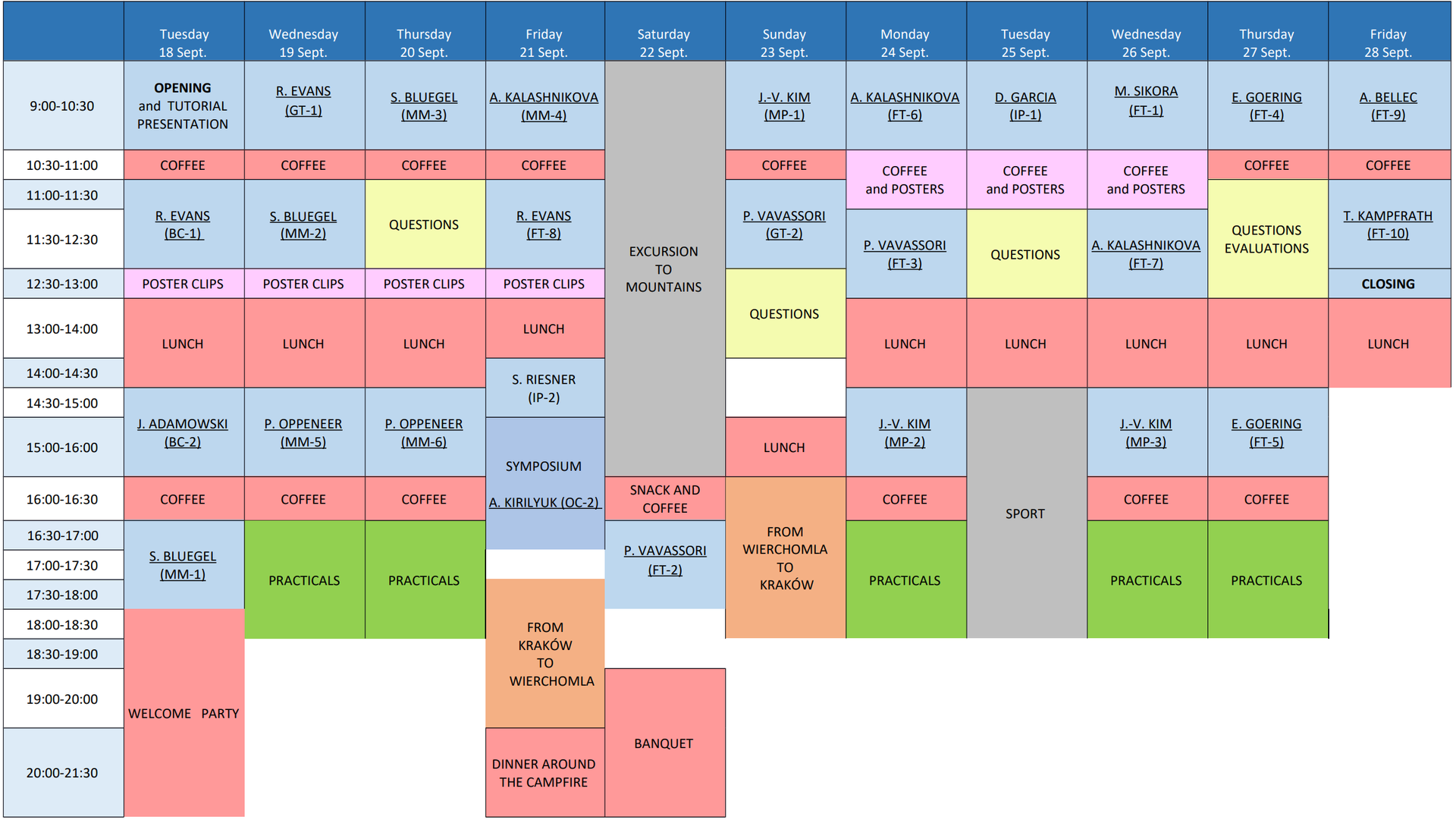Program

The program of the school is in its final form, reflecting the on-site program. All slides are now on-line.
Lectures
Introduction to the School (1h)
- Opening
- Motivation for the School: Marek Pzrybylski, Kraków, Poland ― Chair
I. Basic concepts (4h30)
- Fields, Moments, Units, Magnetostatics: Richard Evans, York, UK [ Abstract | Slides ]
- Magnetism of atoms and ions: Janusz Adamowski, Kraków, Poland [ Abstract | Slides ]
II. Magnetism in matter (9h)
- Electronic and magnetic properties of matter: Stefan Blügel, Jülich, Germany [ Abstract | Slides (Pt1; Pt2) ]
- Magnetic interactions: exchange RKKY. Localized and itinerant magnetism: Stefan Blügel, Jülich, Germany [ Abstract | Slides ]
- Magnetic ordering, magnetic anisotropy and the mean-field theory: Alexandra Kalashnikova, St Petersburg, Russian Federation [ Abstract | Slides ]
- Light-matter interaction: Peter Oppeneer, Uppsala, Sweden [ Abstract | Slides(1) | Slides(2) ]
III. Magnetization processes (4.5h)
- Quasi-static magnetization processes, domain states, nontrivial spin textures: Joo-Von Kim, Orsay, France [ Abstract | Slides ]
- Precessional dynamics, dissipation processes, elementary and soliton excitations: Joo-Von Kim, Orsay, France [ Abstract | Slides ]
- Spin-transfer and spin-orbit torques, current topics in magnetisation dynamics: Joo-Von Kim, Orsay, France [ Abstract | Slides ]
IV. Techniques (3h)
- Micromagnetic and atomistic simulations: Richard Evans, York, UK [ Abstract | Slides ]
- Magnetometry: an introduction: Paolo Vavassori, San Sebastian, Spain [ Abstract | Slides ]
V. Magnetism by light (15h)
- Synchrotron radiation: Marcin Sikora, Kraków, Poland [ Abstract | Slides ]
- Magneto-optics and magneto-plasmonics: Paolo Vavassori, San Sebastian, Spain [ Abstract | Slides (Pt.1, Pt.2) ]
- X-ray magnetic dichroism: Eberhard Goering, Stuttgart, Germany [ Abstract | Slides (Pt.1, Pt.2) ]
- Light-induced (de)magnetization processes and all-optical switching: Alexandra Kalashnikova, St Petersburg, Russian Federation [ Abstract | Slides ]
- The zoo of all-optical magnetic switching - Mechanisms & time-scales: Andrei Kirilyuk, Nijmegen, The Netherlands [ Abstract | Slides ]
- Advanced micromagnetics and atomistic simulations of magnets: Richard Evans, York, UK [ Abstract | Slides ]
- Photo-magnetic transitions: Spin crossover molecules: Amandine Bellec, Paris, France [ Abstract | Slides ]
- Probing and controlling spin dynamics with THz pulses: Tobias Kampfrath, Berlin, Germany [ Abstract | Slides ]
IX. Career perspectives (3h)
Two contributions are scheduled from outside the world of lab research. These are intended to promote thinking about economical, ethical or societal issues, and provide an opportunity to discuss and debate about career opportunities for PhD scientifists beyond their defense.
- Biased Industry Perspective on Basic and Applied Research. Experiences from a PhD on Magnetism in an Engineering World: David García Gómez, Airbus Defense & Space [ Abstract | Slides ]
- Working in a scientific instrumentation company : Stefan Riesner, LOT-QantumDesign, Germany [ Abstract | Slides ]
X. Misc (30min)
- Peter Grünberg, the GMR effects and the birth of spintronics: Stefan Blügel, Jülich, Germany
Other activities
Practicals (4-6h)
Practical are organized to practice the use of numerical, analytical or experimental techniques, related to topics covered by the lectures. Computers will be provided on-site and readily setup for the practicals.
Each practical is typically 2h. Attendees will be asked on-site for their wishes to attend such or such practicals, however it is not possible to attend all of them. On the average, three to four practicals may be attended by each participant.
- Mössbauer spectroscopy and VSM: Marcin Sikora, Kraków, Poland
- Ultrafast introduction to atomistic spin dynamics using VAMPIRE: Richard Evans, York, UK [ Slides ]
- Units in Magnetism:Olivier Fruchart, Grenoble, France [ Questions | Answers ]
- Static micromagentics of domain walls:Olivier Fruchart, Grenoble, France [ Questions | Answers ]
- In-situ magneto-optical Kerr effect characterization and electronic transport measurements of thin films and multilayers: T. Slezak, W. Skowronski, Kraków, Poland
- Experimental methods for magneto-optical Kerr effects measurements: Paolo Vavassori, San Sebastian, Spain [ Slides ]
- Non-linear magneto-optics: Alexandra Kalashnikova, St Petersburg, Russian Federation [ Slides ]
- Static micromagnetics of domain walls (with Dzyaloshinskii-Moriya): Joo-Von Kim, Orsay, France
- Dynamic micromagnetics of domain walls: Joo-Von Kim, Orsay, France
- X-ray spectroscopy and microscopy, synchrotron light generation: Marcin Sikora, Kraków, Poland
- How to measure ultrafast spin and charge currents: Tobias Kampfrath, Berlin, Germany [ Slides ]
Library
A library consisting of a large set of books dedicated to various aspects of Magnetism is on display during the entire School. Its purpose is first to get students aware of the existing books, get acquainted with their use, and also serve as a support for activities during the School. See the list of books on display at ESM2017.
Question-Answer sessions (5-10h)
The purpose of a research School is to provide young scientists with the basics in a working field. With this respect interactivity between students and lecturers should be promoted. Like in the previous editions, a key aspect of this interactivity is the possibility to raise questions at the end as well as during the course of the lectures. Besides, several sessions of questions take place, during which the lecturers or voluntary students present in more detail issues raised by the students during the lectures or anonymously through a question-box. See the list of questions raised in 2018.
Posters
We encourage participants to bring posters to present their work. Students are asked to present their poster in a one-slide-two-minutes presentation as an exercice to summarize their work.









